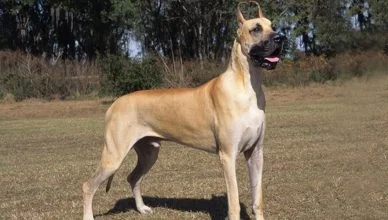Great Danes are large, strong, imposing dogs with broad heads, massive jaws, and a long muzzle. Their coat is short, smooth, and glossy. Danes are known for their intelligence as well as their strength. They are one of the most intelligent breeds of dogs in the world.
This article will discuss the appearance of the Great Dane, including its physical characteristics and how it may differ from other breeds of dogs.
Great Dane Appearance
The Great Dane has an appearance of their own that makes them one of the most popular breeds in the world. They are often described as having an imposing, dignified, and regal look. They are known for their distinct facial features that make them appear extremely serious.
Here’s a detailed look at what an adult Great Dane can look like:
Great Dane Head and Facial Features
The Great Dane has a broad head, a strong forehead, and a long muzzle with a wide gap that can easily accommodate large meals. The sides of the breed’s skull are almost always perfectly parallel. Their ears are set low on the head. The eyes are large and almond-shaped with dark rims around them; they are set close together in order to balance the oversize head. The facial difference between a male and female Great Dane is that the male tends to have more pronounced facial features than the female, including an angular skull with bonier jowls, while the female has a more rounded head with more delicate cheekbones.
The deep-set muzzle of a Great Dane should match their body proportions for an aesthetic appeal. In Great Danes with pet-quality breeding, the upper lip of their muzzle hangs down the lower jaw and droops when they run.
Great Dane Body Structure
The Great Dane is known for having a long and muscular body, and they’re often sought after due to this feature. In addition to their athletic forms, they tend to have a few other physical traits which boost their regal looks. With a heavy bone structure, there are two humps on the back of this dog’s skull that rise up to create an impressive ridge along the spine. Their tail is long and smooth, reaching down to the hocks. There’s a rule of thumb when it comes to their tails: the tail should never be raised higher than the back. So while the tail may sometimes come up while they run, keeping it low is important according to breed standards.
Great Danes are well-known for their long legs that enhance their large stature and serious personality. A giant Great Dane looks formidable, but it’s actually mostly their legs that make an imposing stature. Their long legs are proportionate to the rest of the body. Because of this, Danes get most of their height and they can outrun most other dogs!
Great Dane Size
So, how big can a Great Dane get? The Great Dane is one of the largest breeds of dog in existence, standing from 28 to 34 inches tall at the shoulder and weighing up to 200 pounds!
Coat Type
Danes are known for their glossy coats that help them maintain a cool body temperature. Their coat is short and single that typically sits close to their body.
Coat Colors
Great Danes have a sleek and short coat, but they are more known for their wide color variations. They have more accepted show/breed standards for color varieties than most breeds. The coat comes in 7 show-approved shades of fawn, brindle, black, blue, harlequin, mantle, and merle. Each of these colors has its own distinct markings and patterns.
Other than AKC accepted show colors, there are also other non-standard color varieties that you may find in a Great Dane:
- White
- Mantle anything but black
- Merlequin color with only patches of merle
- Blue-based brindles
- Blue-masked fawn
Conclusion
The Great Dane is one of the most regal and lovable dogs that is almost impossible to forget once you’ve seen them. Their large size and striking coat make them a pet many people are drawn to. They are charming, intelligent, and extremely loyal which makes them great for children and other family members.
Thank you for reading the article.
To explore more, here are other Great Dane-related articles that you might be interested in.
Comment down below if you have a Great Dane. We would love to hear from you!
